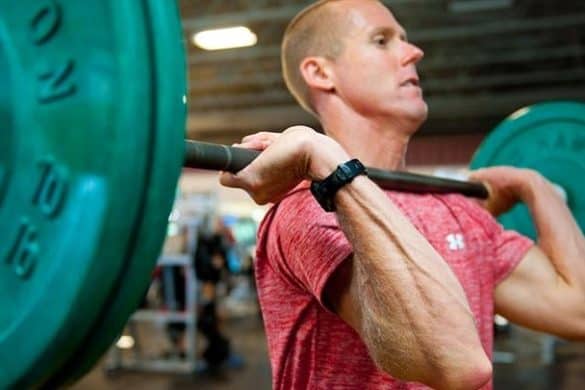This is the definitive guide on how to bulk up fast without getting fat. But…
Before you rush into making any changes to your diet or training, you might like to first consider (click to jump down to the question):
Does science show that bulking and cutting is the best way to gain muscle?
Disclaimer: In this guide, we recommend bulking and cutting for some people who need to build strength quickly. However, you should discuss any alterations in medication, diet and relevant lifestyle changes with your doctor.
Within this guide, we’re going to take you (step by step) through the science and strategy for a successful bulk and cut by showing you:
- How much to consume (based on your daily intake)
- The type of macronutrients to incorporate
- How often to bulk
- Plus a lot more here in the…
Contents:
- What is bulking and cutting?
- Do you really need to bulk and cut to build muscle?
- Why do people bulk and: who is this guide for?
- How does eating more and training consistently help you build muscle?
- Should you get fat when bulking?
- How much should you eat to bulk?
- What are the right macronutrients for bulking?
- How often to eat to bulk up?
- How often to bulk and cut?
- How many reps to bulk up?
- How often to train in order to bulk up?
Ready to build some strength the right way?
Let’s jump into it.
What is Bulking and Cutting?

As you may already know, weight training is widely associated with two main periods:
- Bulking
- Cutting
The “bulking period” is where you gain weight by consuming more calories than necessary which is then followed by the “cutting period” where the goal is to lose as much fat as possible with as little muscle as possible.
Do You Really Need to Bulk and Cut to Build Muscle?
In short, it depends on your goals and multiple factors I’m about to cover.
I personally bulk during the winter and cut during the summer but… does this mean you have to do the same thing as me?
No, you don’t, because science shows us that we can build muscle both when bulking and on a calorie-restricted diet.
As you can see in the graph below, the more energy (calories) and protein you consume, the bigger your muscles will grow (up to a certain point):

Note: The participants did not workout throughout both of the studies above yet they still gained Lean Body Mass and energy expenditure by 200 kcal towards the end of the study. [1]

The chart above demonstrates how an increase in protein will result in a greater increase of LBM.
Now, while this limited data does show that consuming more can result in a greater lean body mass (LBM), it doesn’t mean you need to dirty bulk (massively over-eat).
- Dirty bulk = 1000+ calories over your daily requirements (energy expenditure)
- Gradual bulk = 250-500 calories over your daily requirements (energy expenditure)
In fact, the same study shows that if you dirty bulk, your fat mass will increase (without a significant increase in muscle mass):

So, it looks like a gradual bulk can be better than a dirty bulk if you’re trying to avoid an increase in body fat, but…
Does it mean you should still bulk slowly?
Not necessarily.
You can still gain muscle in a caloric deficit [2] depending on whether or not you have enough sleep, rest, muscle-building genetics [3], nutrition, and a fantastic strength training programme but… it’s just going to be a slightly slower process.
An example of an athlete who doesn’t bulk and cut would be Jeff Cavaliere, who, over the course of twenty years has slowly and steadily increased lean body mass without building any body fat.
Within the clip below, Jeff Cavaliere argues why you don’t have to bulk and cut at all and instead… look great year-round like Jeff does:
Summary of what was said in the video above:
“If over the long run you’re looking for a great looking body year-round, then bulking is not the strategy you should take.
Here are two reasons why:
-
The majority of people who bulk are unable to lose weight on the cut because it requires a lot of discipline to lose body fat after gaining the habit of eating more.
-
Bulking up with more food than is required is not the only factor for muscle growth as you’ve also got to factor in insulin sensitivity; genetics; testosterone to cortisol ratio; your ability to recover from workouts; muscle fibre makeup; what supplements you are taking; and what training programme you are following.”
In other words: Bulking can be more ineffective in comparison to training consistently and eating within your total daily energy expenditure. [4]
So if this guide is about how to bulk and cut…
Why Do People Bulk and: Who is This Guide For?
People bulk because they either are:
A) Competing bodybuilders who need to consume as much as possible in order to quickly increase muscle mass before cutting before a competition.
B) People who are looking for quick results.
But, as we’ve already shown in the heading above, bulking isn’t always a good idea for people looking for fast results.
So this guide is for competitive bodybuilders or determined fitness enthusiasts who will be able to lose the acquired body fat and break the habit of eating in an excess, which, was acquired during the bulking phase.
How Does Eating More and Training Consistently Help You Build Muscle?
Weight training breaks your muscles fibres down and eating food provides the building blocks for new muscle tissue. The combination of both of these factors will help you to effectively bulk.
Here is a brilliant video by Ted Education which explains how muscles grow:
Should You Get Fat When Bulking?
When you bulk, you consume more food than is required for the ability to build new tissue (muscle mass). But here’s the thing…
If you bulk up too aggressively, you will gain fat, which will result in having to spend more time cutting afterwards (something many people struggle doing).
Micro-managing your bulking period is essential to retaining those gains during the shredding period which comes afterwards.
This leads us to the question…
How Much Should You Eat to Bulk?

As you already know: gaining muscle mass is best done in a caloric surplus [5], meaning that you will be consuming more food than your body needs to maintain its weight.
Why?
Because eating slightly more than necessary will give your body the resources to generate the new mass you desire [6].
So how much more do you need to eat?
A successful bulk to help maximise gains and minimise fat would be 250-500 calories above your maintenance levels (total daily energy expenditure) per day. In other words:
You will want to aim for a gain of about 1 kilogram per month.
Will you still gain fat?
Yes, you may look a bit softer and bulkier when standing in front of the mirror but this is the part of the process as your body is retaining water, glycogen and usable resources for a successful cut.
Insufficient consumption of food is one of the reasons why I struggled to put on weight in the beginning but it’s what has helped me get a stronger looking body today.
Summary: Lean muscle gains occur optimally in a slight caloric surplus of 250-500 calories, which gives the body enough energy for the generation of new muscle tissue. The optimal rate of weight gain is about 1 kilogram per month.
Moving on to…
The Perfect Calculator Which Shows You How Many Calories to Bulk
One of the best things about our age of technology is: we have all the tools needed to make changes to our bodies.
When it comes to optimising weight and re-gaining your control over it, an accurate calorie calculator is one of the best things you can use.
Below is a link to one of the most accurate calorie calculators to give you a broad calculation.
Click here to use the calorie calculator.
But is Calorie Counting the Only Way to Manage Both Your Bulking/Cutting Period?
While some research does show that people who log calories are better able to both increase and lose weight [7, 8, 9], you still want to take calorie counting with a pinch of salt [10].
Why?
Because calories on your food labels are disproportionately incorrect as kcals depend on:
- What we consume.
- How that food or drink is prepared.
- Which bacteria is present in our gut.
- Your bodies energy requirements for digest different foods.
In other words: Food label calories essentially involve average factors which overlook the intricacies of the type of food we eat, the process the food goes through, and the digestion [11].
For example, almonds can account for just 129 calories per serving in comparison to the labelled 170 calories according to the Janet A. Novotny and the USDA’s new study [12].
So What Do the Inaccuracies of Calorie Counting Mean for Your Ability to Bulk and Cut Successfully?
The inaccuracies mean you will need to consistently monitor how your weight changes and adjust your food intake respectively.
Use the information on the table below to help you monitor your weight loss/weight gain.
[table id=7 /]
Summary: Using a calorie calculator may help you monitor your weight and will help you understand your bodies average daily energy requirements but: you will still have to monitor your weight and tweak food intake respectively, until you reach the desired rate of weight gain, which is ~1 kg per month.
The Right Macronutrients for Bulking
What Are Macronutrients?
You probably already know that micro means all things small whereas macro means all things big.
The nutrients we require in relatively large quantities are known as macronutrients (carbohydrates, proteins, fats) whereas micronutrients (dietary fibre, minerals, vitamins) are needed in smaller quantities.
So when we broadly classify nutrients based on what our nutritional needs are to survive, we say: macronutrients (carbohydrates, proteins, and fats) and micronutrients (vitamins and minerals).
The government’s dietary guidelines follow the macronutrient approach whereby you have more protein and carbohydrates in comparison to fats. But this diet isn’t set in stone because…
Researchers and dieticians have found that the ketogenic diet and low-fat diet (two very different macronutrient diet approaches) might be just as good a diets [13].
But, as the majority of you reading this will be following the standard macronutrient approach illustrated above…
Let’s talk about how much of each macronutrient may be required for a successful bulk.
How Much Protein to Bulk?
Studies have shown that the optimal daily amount of protein ranges from 1.75-2.2 grams of protein, per kilogram of body weight [14].
The number varies, depending on body composition, meaning that someone with more muscle mass and less fat would be on the upper range of the spectrum.
If you think about it, the majority of your muscle mass is made up of proteins (and water).
Furthermore, the word “protein” in and of itself means “first, the primary”, derived from the Greek “Protos”.
Knowing these facts, you can easily conclude that protein is the first and most important macronutrient you have to consider in your daily menu.
Meat and poultry are the best sources of protein, as they have the full amino acid profile, thus being of greater biological value [15].
Optimal lean bulk daily protein intake forms at 0.8-1 g of protein per lb. of bodyweight, depending on body composition and… the more muscle mass you have, the more protein you will need.
What Types of Protein Should You Consume in Order to Bulk?
Protein can come in the form of complete, incomplete, and complementary proteins.
- Complete protein: A full amino acid protein source which could include meat, dairy and eggs.
- Incomplete protein: Foods containing at least one amino acid such as beans, grains, and legumes.
- Complementary protein: Food where protein can be added to make a complete protein such as eggs with toast, or beans with rice.
Now, any of the above are great sources of protein with a mixture of all ensuring a well-balanced diet. But here’s the problem with protein, or any food for that matter:
Avoid processed foods with high added sugar, fat, and salt content
Why should you avoid processed foods if you’re trying to bulk?
Some of the reasons why processed foods are bad (when consumed in excess) include:
- Addictiveness: According to Yale Food Addiction Scale (YFAS) research [16], 10-15% of people suffer from food addiction and common foods associated with addiction include those high in sugars, fats, and salts. Also, once body fat has been put on in late quantities, it can be difficult for some people to burn it back off both physically and mentally.
- Depression: Processed foods typically contain trans fats which are known to cause aggression, irritability, and depression [17, 18].
- Increased risk of cancer: A study of 100,000 participants said “if you increase your consumption of ultra-processed foods by 10% over a 5 year period you may have a 10% higher risk of overall cancer (particularly breast cancer) [19].
With these studies in mind, here are some examples of the most common moderately to highly processed protein food to avoid:
- Deli meats (cold meat common in sandwiches)
- Hot dogs
- Processed cheese
- Sugary protein bars/shakes
Some examples of unprocessed protein food to incorporate into your diet include:
- Free-range meats like chicken, turkey, steak (on occasion).
- Dairy products such as cheeses (stilton, cheddar, parmesan) and yoghurt (without added sugars, flavourings or preservatives).
- Nuts (avoid the salted/flavoured nuts).
Now, what about fats?
How Many Fats to Bulk?
Optimal fat intake forms at 0.35-0.45 grams per lb of bodyweight, per day.
Dietary fat is the second most important macronutrient, as it serves a variety of functions.
Some of these functions include:
- Cell growth
- Body energy
- Nutrient absorption
One of the most important things, however, is the fact that a deficit of fatty acids, may lead to a decline in endocrine (hormonal) function according to studies [20].
This is exactly why fats should represent at least 15-20% of your total daily caloric intake.
Dietary fat is the second most important nutrient after protein, as it plays key roles in the endocrine system of the body. Fats should make up about 20% of your total daily energy intake.
What Types of Fats Should You Have?
Bad fats you should avoid or have only on special occasions:
- Sweet puddings: High in sugars and additives (cakes, pastries, cookies, etc).
- Fried food: Usually contains high amounts of trans fats and processed ingredients.
- Milkshakes: Sometimes contains large quantities of both fat and sometimes fructose corn syrup – although feel free to make your own healthy milkshake.
Good fats you can consume daily:
- Avocados: Rich in vitamins C, E, K, and B-6 (and more).
- Fish: Filled with omega-3 fatty acids (and more).
- Coconut oil: Packed with health-boosting nutrients and minerals.
Lastly, what about the carbs…?
How Many Carbs to Bulk?
Though carbohydrates are the king of high-intensity performance, they’re not essential [21].
The body can make its own glucose in a process called “Gluconeogenesis”, or in simple terms: the process of glucose production, from non-carbohydrate precursors.
For this reason, you can prioritise the amount of protein and fat calories you’re going to have and then leave the rest of the calories to carbohydrates as you can see below:
[table id=8 /]
To calculate your daily carb intake, take the remaining number of calories after calculating fats and protein, and divide it by 4.
How Often to Eat to Bulk Up?
Another factor you can consider when striving for a lean bulking phase is meal frequency.
And while total daily energy intake is what will primarily determine the change in weight, there are subtle tricks you can use to gain more leverage for success.
For example, consuming 0.5 grams of protein per kilogram of body weight, within 2 hours on both sides of training, has been shown to improve the anabolic (constructive) response of the body but… [22] overall:
Meal frequency won’t make much of a difference so pick what you can adhere to.
How Often to Bulk and Cut?
One of the biggest mistakes many trainees make is not periodizing their training correctly and not knowing how often to bulk.
The best approach one can take on bulking and cutting is to build the plan around seasonal changes.
Why?
Because a hot summer may be a more active time in the year for you and even the heat itself may help you reach a caloric deficit (although studies this is merely theory rather than evidence-based [23]) therefore being a great time-of-year to lose body fat.
On the other hand, the winter (especially during Christmas) would make it easier to get into a caloric surplus and could, therefore, be the perfect time to bulk up.
Spring and autumn can be used as a transition/recovery period, during which you slowly switch between bulking and cutting phases.
So how much to bulk up before cutting? Well, until you start looking softer and the definition starts to fade, but that is generally 6-9 months.
Now, if you’re looking to cut your weight off, check out our sister article “How To Lose Fat Fast” here!
Structuring your training around seasonal changes is the may be a good way to make use of periodization. Cut during the hotter seasons and bulk during the colder ones. Generally, a good bulk will last 6-9 months and a good cut will last 2-4 months.
How Many Reps to Bulk Up?
While food is an important deciding factor for a successful bulk, an even more important factor is: your training.
The 6-12 rep range is a suitable range when the goal is bodybuilding-type growth [24, 25].
There are two types of muscle growth you can achieve:
- Myofibrillar growth: The growth of the muscle fiber itself.
- Sarcoplasmic growth: The growth of the jelly-like fluid surrounding the muscle fibre.
The first type (myofibrillar) is can be made in the strength-training range of 1 to 5 repetitions.
Myofibrillar may be better for explosive athletes to train in this range more frequently (according to Certified Strength and Conditioning Specialist Ryan Sprague [26]) because it incorporates additional contractile units to each muscle cell. However…
Myofibrillar growth may not lead to significant changes in size and weight but instead: greater strength and power.
The second type (sarcoplasmic growth) is mainly obtained when the repetition volume grows (6+ repetitions).
Sarcoplasmic growth occurs in higher repetition volumes because more repetitions increase muscle cell fluid within the sarcoplasm, therefore making the muscles look bulkier.
As you may have guessed already, the second type (sarcoplasmic growth) will help you not only become stronger but also: look stronger.
Different rep ranges produce different growth and adaptations. For a lean bulk, it would be best to spend your time primarily in the 6-15 rep range, but also exercise the 1-5 rep range every now and then to stimulate strength development.
How Often to Train to Bulk Up
Another thing to consider when going into a lean bulk is your training frequency.
It is important to give your muscles enough time to recover between each workout you do as…
A muscle group may need 48-72 hours to recover completely and reach the state of “Supercompensation” [27].
Supercompensation is the post-training period, during which the exercised muscle group/function has a higher capacity than it did prior to the training session (in other words, your gains).
The best time to train the muscle group again is when the state of supercompensation has been reached.
Think about it, if a muscle group recovers in about 96 hours and you only train it once a week, you’ll be missing out on reaching its full potential [28].
Training each muscle group every 48 to 96 hours is the best approach, as it will allow you to exert the highest amount of volume and intensity, while also training the muscle group at its peak state of recovery.
Conclusion
A successful lean bulk is the result of the right training with the right nutrition.
If you are someone who wants to gain muscle with little to no fat gains, here is a breakdown of what you SHOULD be doing:
- Consume food at a slight caloric surplus.
- Aim for 2g of protein & 1g of fat (per kilogram of body weight, daily).
- Leave the rest of the calories to carbs after calculating protein and fats.
- Periodize your training around seasons (bulk during winter, cut during summer).
- Primarily focus on the 6-15 rep range and go to the strength training range (1-5 reps) every now and then.
- Train each muscle group every 48-96 hours.
If you do all of the above, you will bulk up whether you’re a skinny gym-goer or a professional body-builder.
Now I’d like to turn it over to you:
What’s your favourite food to bulk up with?
Do you like to bulk and cut or…
Perhaps you prefer building muscle whilst maintaining your body weight?
Either way, let me know by leaving a comment below.
Also: Follow us on Instagram here so you can receive valuable insights to your feed!










